Crystal Meth Addiction: Definition, Symptoms, Effects, and Treatment
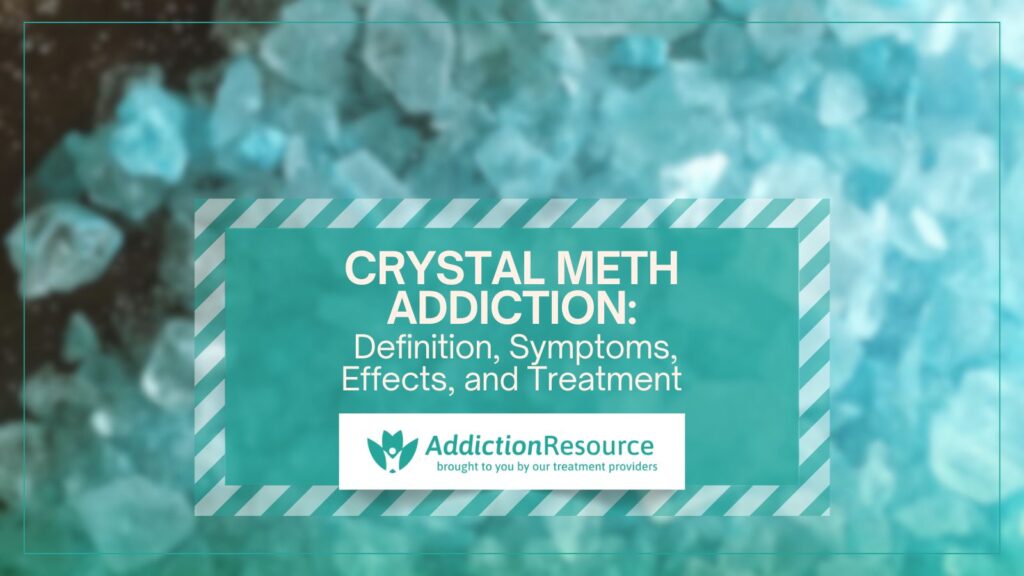
Crystal meth addiction is the dependence on methamphetamine, a potent and illegal stimulant affecting the central nervous system. Methamphetamine addiction starts with recreational use to experience intense euphoria or increased energy, but prolonged misuse leads to crystal meth abuse or meth addiction.
The main symptoms of crystal meth addiction are intense cravings, sleep disturbances, mood swings, weight loss, and neglect of responsibilities. Causes of addiction include peer pressure, mental health disorders, and repeated use to escape stress or enhance performance.
Crystal meth addiction results in severe adverse effects such as cognitive decline, heart problems, social isolation, financial troubles, and an increased risk of overdose. Treatment options include medical detox, behavioral therapies like cognitive-behavioral therapy, medication, support groups, and residential rehabilitation programs.
Table Of Contents:
- What is Crystal Meth Addiction?
- How is Crystal Meth Consumed?
- How Common is Crystal Meth Addiction?
- What are the Causes of Crystal Meth Addiction?
- What are the Symptoms of Crystal Meth Addiction?
- What are the Effects of Crystal Meth Addiction?
- What are the Treatment Options for Crystal Meth Addiction?
- What is Crystal Meth Withdrawal?

What is Crystal Meth Addiction?
Crystal meth addiction is a long-term condition when a meth head cannot stop using crystal meth, a potent and highly addictive drug that affects the nervous system. Meth triggers the release of an excessive amount of dopamine, creates intense feelings of euphoria, heightened energy, and increased focus. These effects lead to repeated use and methamphetamine abuse, according to research published by the National Institute on Drug Abuse (NIDA), titled “Methamphetamine.”
Crystal meth is known by various street names like Ice, Tweak, Glass, Chalk, and Speed. It is a synthetic drug abused for its stimulating effects. The prolonged use causes severe health effects, such as cognitive impairments, emotional instability, and physical damage, indicating the dangerous nature of crystal meth powder.
How is Crystal Meth Consumed?
Crystal methamphetamine is consumed in four different ways, including smoking, snorting, injecting, or ingesting it orally. Smoking is one of the most common methods, where the drug is heated and inhaled through a pipe, producing an immediate and intense high. Snorting involves inhaling the powdered form of meth through the nose, leading to a slower onset of effects compared to smoking.
Injecting meth involves dissolving it in liquid and using a syringe to deliver the drug directly into the bloodstream for a rapid and intense experience but carries high risks of infections and overdose. Meth heads ingest crystal meth orally in pill or tablet form, producing effects that last for extended periods.
How Common is Crystal Meth Addiction?
Crystal methamphetamine addiction is a significant concern in the United States. Approximately 2 million individuals aged 12 or older reported using methamphetamine in the past year, representing about 0.7% of the population, according to the 2019 National Survey on Drug Use and Health, SAMHSA, titled “Key Substance Use and Mental Health Indicators in the United States.”
Methamphetamine use is more prevalent among men than women, with usage rates of 8.7 per 1,000 men compared to 4.7 per 1,000 women. Individuals aged 26 to 34 exhibit the highest usage rates at 11.0 per 1,000. Racial and ethnic disparities are also evident; non-Hispanic White individuals have a usage rate of 7.5 per 1,000, while non-Hispanic Black individuals have a lower rate of 2.5 per 1,000, according to the demographic data from the Centers for Disease Control and Prevention (CDC), titled “Patterns and Characteristics of Methamphetamine Use Among Adults.”
What are the Causes of Crystal Meth Addiction?
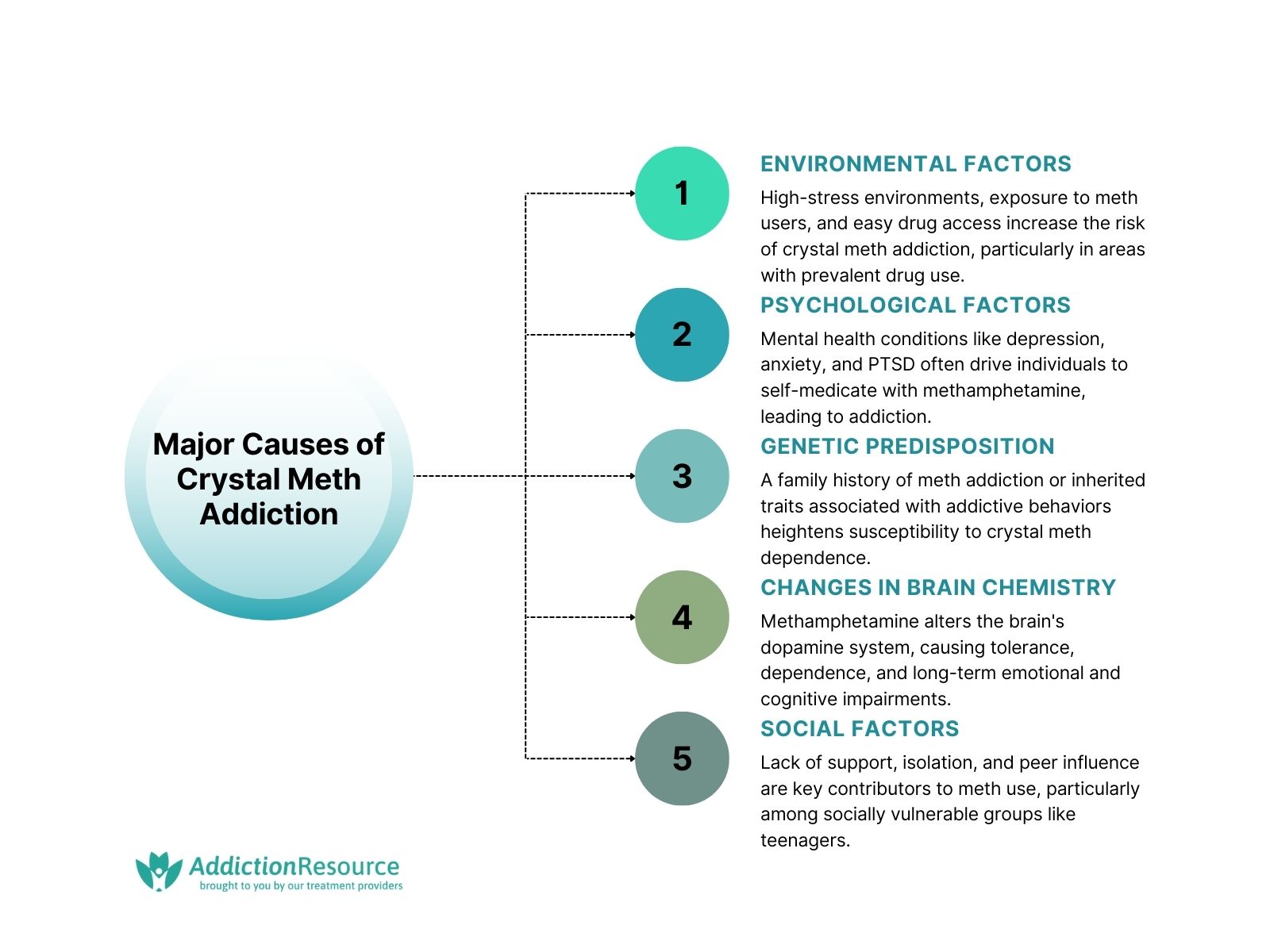
The causes of crystal meth addiction include environmental factors, psychological factors, genetic predisposition, and changes in brain chemistry.
The 5 major causes of crystal meth addiction are listed below.
- Environmental Factors: Environmental factors such as high-stress surroundings, exposure to meth addicts, and easy access to methamphetamine are direct causes of crystal meth addiction. These three factors increase the chances of meth addiction. Individuals in stressful or drug-prevalent areas are more prone to methamphetamine abuse, according to the research published in 2009 by Ann N Y Acad Sci, titled “Chronic Stress, Drug Use, and Vulnerability to Addiction.”
- Psychological Factors: Psychological disorders such as depression, anxiety, and PTSD (Post-traumatic stress disorder) are important causes of crystal meth addiction. These factors lead individuals to use methamphetamine as a form of self-medication and increase the risk of methamphetamine addiction. There is a strong correlation between psychological distress and methamphetamine abuse, according to research published in 2020 by the National Institutes on Drug Abuse (US), titled “Common Comorbidities with Substance Use Disorders.”
- Genetic Predisposition: Genetic predisposition is a primary cause of crystal meth addiction. A family history of methamphetamine abuse makes individuals more susceptible to developing an addiction to methamphetamine. Certain inherited traits influence addictive behaviors, according to a study published in 2012 by the National Library of Medicine titled “The Genetic Basis of Addictive Disorders.”
- Changes in Brain Chemistry: Chronic use of methamphetamine causes major changes in brain chemistry, especially in the dopamine system. The alteration of brain chemistry leads to meth tolerance and dependence. There are significant changes in areas of the brain associated with emotion and memory in chronic meth-addicted people.
- Social Factors: Lack of social support, isolation, and association with people who use methamphetamine are critical social causes of addiction. Social networks play a crucial role in influencing methamphetamine use behaviors among teenagers.
What are the Symptoms of Crystal Meth Addiction?
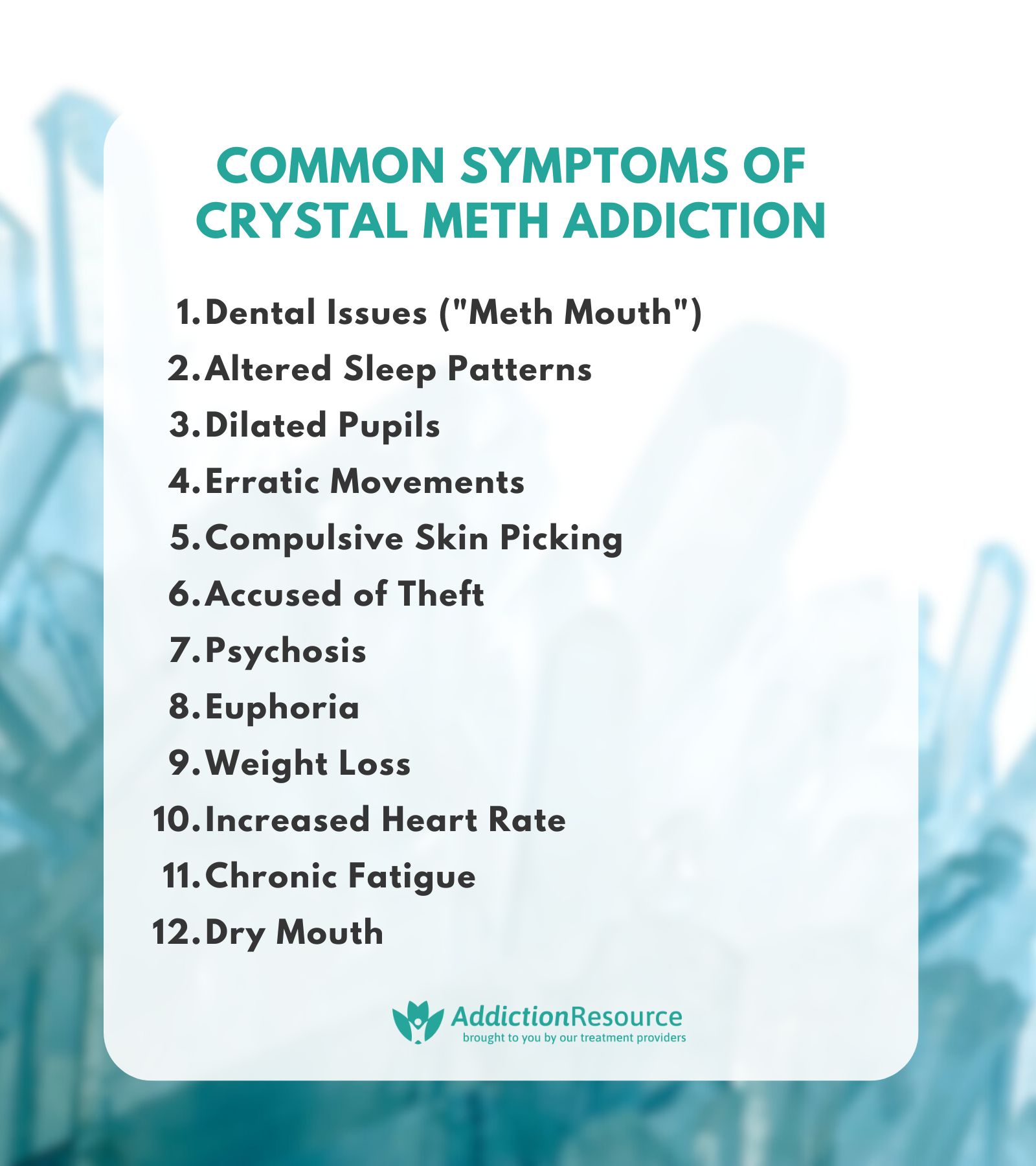
The symptoms of crystal meth addiction include dental issues, altered sleep patterns, confusion, compulsive skin picking, psychosis, weight loss, euphoria, chronic fatigue, dry mouth and dilated pupils.
The 12 common symptoms of crystal meth addiction are listed below.
- Dental Issues (“Meth Mouth”): Crystal meth use causes severe tooth decay and gum disease known as “meth mouth.” Meth mouth results from a combination of dry mouth (caused by reduced saliva production), poor oral hygiene, and teeth grinding. A team from the Tygerberg Oral Health Centre at the University of the Western Cape’s Faculty of Dentistry studied the effects of tik on the oral health of meth addicts. They found that tik causes severe dental and gum issues, including tooth decay and gum disease.
- Altered Sleep Patterns: Methamphetamine’s stimulant effects disturb the natural sleep-wake cycle of the body and cause prolonged wakefulness and insomnia. Meth users experience persistent sleep disturbances even after the drug’s effects wear off.
- Dilated Pupils: Crystal meth overstimulates the nervous system and causes enlarged pupils (dilated eyes). Pupil dilation and constriction regulate the amount of light entering the eyes and ensure clear and proper vision. When pupils fail to dilate or constrict properly, it signals the beginning of a vision problem. Crystal meth affects the nervous system and causes enlarged pupils.
- Erratic Movements: Crystal meth use causes erratic movements, such as twitching, jerking, or repetitive actions, because of its powerful stimulant effects on the nervous system. These involuntary movements are linked to the methamphetamine impact on the brain and lead to overstimulation and loss of motor control.
- Compulsive Skin Picking: Meth-induced hallucinations and obsessive behaviors directly lead to excessive scratching and skin picking. Skin scratching and picking results in visible sores and infections. Face sores are a common side effect of meth use, caused by excessive scratching and skin picking.
- Accused of Theft: Crystal meth addiction directly push people to steal to pay for their drug use. The strong cravings and dependence on Methamphetamine drive meth-addicted persons to prioritize obtaining meth over legal and moral boundaries.
- Psychosis: Crystal meth addiction impacts the brain and directly causes psychotic behavior, including paranoia, hallucinations, and violent outbursts. Methamphetamine causes intense distortions in reality, making a meth-addicted person feel fearful, aggressive, or disconnected from reality.
- Euphoria: Methamphetamine triggers a powerful release of dopamine in the brain and produces intense feelings of pleasure and well-being. The sense of euphoria leads to repeated consumption as meth-addicted people chase the high.
- Weight Loss: Methamphetamine directly suppresses appetite and leads to unhealthy weight loss and malnutrition. Chronic meth users neglect proper nutrition, resulting in malnutrition and weakened physical health.
- Increased Heart Rate: Crystal meth’s stimulant effects on the cardiovascular system directly cause increased heart rate and a high risk of serious health problems. An increase in the heart rate causes heart attacks and strokes in meth addicts.
- Chronic Fatigue: Meth users experience chronic fatigue and exhaustion during withdrawal as the body recovers from the overstimulation caused by the methamphetamine.
- Dry Mouth: Crystal meth reduces saliva production and directly leads to dry mouth, discomfort, and serious dental problems, including tooth decay.
What are the Effects of Crystal Meth Addiction?
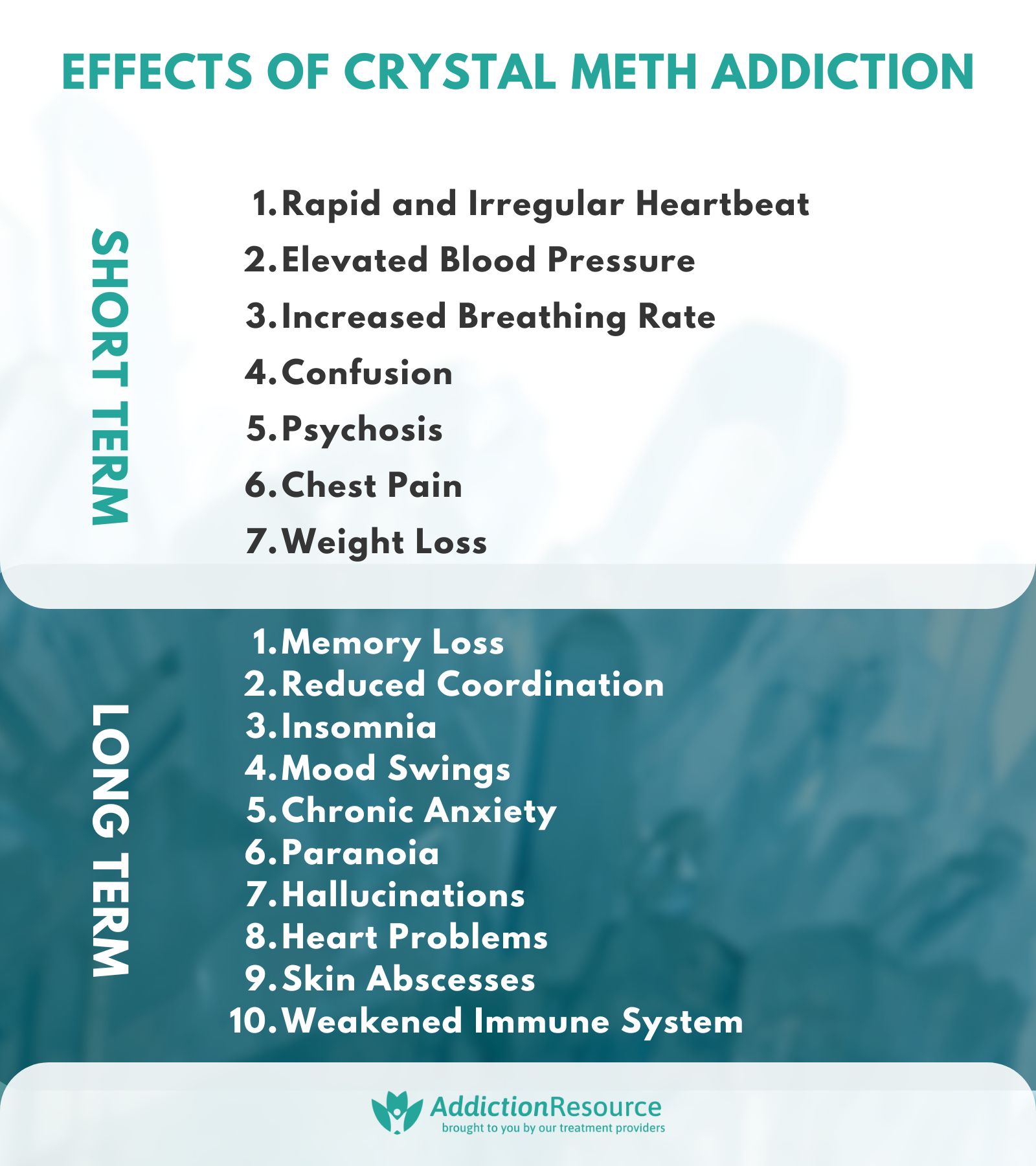
The effects of crystal meth addiction are classified into two categories; short-term and long-term effects. Short-term effects include rapid and irregular heartbeat and increased breathing rate. At the same time, long-term effects include paranoia and mood swings.
Short-term Effects of Crystal Meth Addiction?
The short-term effects of crystal meth addiction are increased breathing rate, confusion, chest pain, psychosis, and weight loss.
The 8 short-term effects of Crystal Meth Addiction are listed below.
- Rapid and Irregular Heartbeat: Crystal Meth addiction accelerates heart rate and causes arrhythmias, increasing the risk of cardiovascular complications, according to research conducted by the National Institute of Drug Abuse, titled “Methamphetamine Inhibits Long-Term Memory Acquisition and Synaptic Plasticity by Evoking Endoplasmic Reticulum Stress” in 2021.
- Elevated Blood Pressure: Methamphetamine raises blood pressure levels, heightening the risk of strokes and heart attacks in meth addicts.
- Increased Breathing Rate: Meth-addicted people experience faster respiration, which leads to respiratory issues and exacerbates existing conditions.
- Confusion: Meth addiction impairs cognitive functions, resulting in disorientation and difficulty concentrating.
- Psychosis: High doses of methamphetamine lead to paranoia, hallucinations, and delusional thinking, resembling schizophrenia.
- Chest Pain: Cardiovascular strain from using meth causes chest pain and leads to a high risk of heart problems.
- Weight Loss: Crystal Meth suppresses appetite and leads to significant and unhealthy weight loss.
Long-term Effects of Crystal Meth Addiction?
Long-term effects of crystal meth addiction include memory loss, reduced coordination, mood swings, paranoia, chronic anxiety, and insomnia.
The 10 permanent effects of crystal meth addiction are written below.
- Memory Loss: Chronic use of methamphetamine leads to deficits in thinking and motor skills, including memory loss, according to research published in 2020 titled “Methamphetamine Inhibits Long-Term Memory Acquisition and Synaptic Plasticity by Evoking Endoplasmic Reticulum Stress.”
- Reduced Coordination: Prolonged use of crystal meth impairs motor skills, resulting in decreased coordination and increased risk of accidents.
- Insomnia: Acute and long-term sleep problems are among the most concerning effects of methamphetamine abuse, presenting a significant therapeutic challenge.
- Mood Swings: A meth-addicted person exhibits rapid mood changes, including irritability and aggression, due to alterations in brain chemistry.
- Chronic Anxiety: Long-term use of crystal meth causes ongoing anxiety disorders such as excessive worry and nervousness.
- Paranoia: Crystal meth addiction causes irrational distrust of others accompanied by delusions of persecution and extreme suspicion.
- Hallucinations: A meth-addicted person experiences false sensory perceptions, such as seeing, hearing, or feeling things that are not actually present, causing psychotic episodes.
- Heart Problems: Prolonged use of crystal meth increases the risk of cardiovascular complications, including elevated heart rate, high blood pressure, heart palpitations, and heart attacks.
- Skin Abscesses: A chronic meth-addicted person develops skin sores and infections resulting from obsessive skin picking, poor hygiene, and reduced immune function.
- Weakened Immune System: Chronic meth use suppresses the immune system, making meth-addicted people more susceptible to infections and illnesses.
What are the Treatment Options for Crystal Meth Addiction?
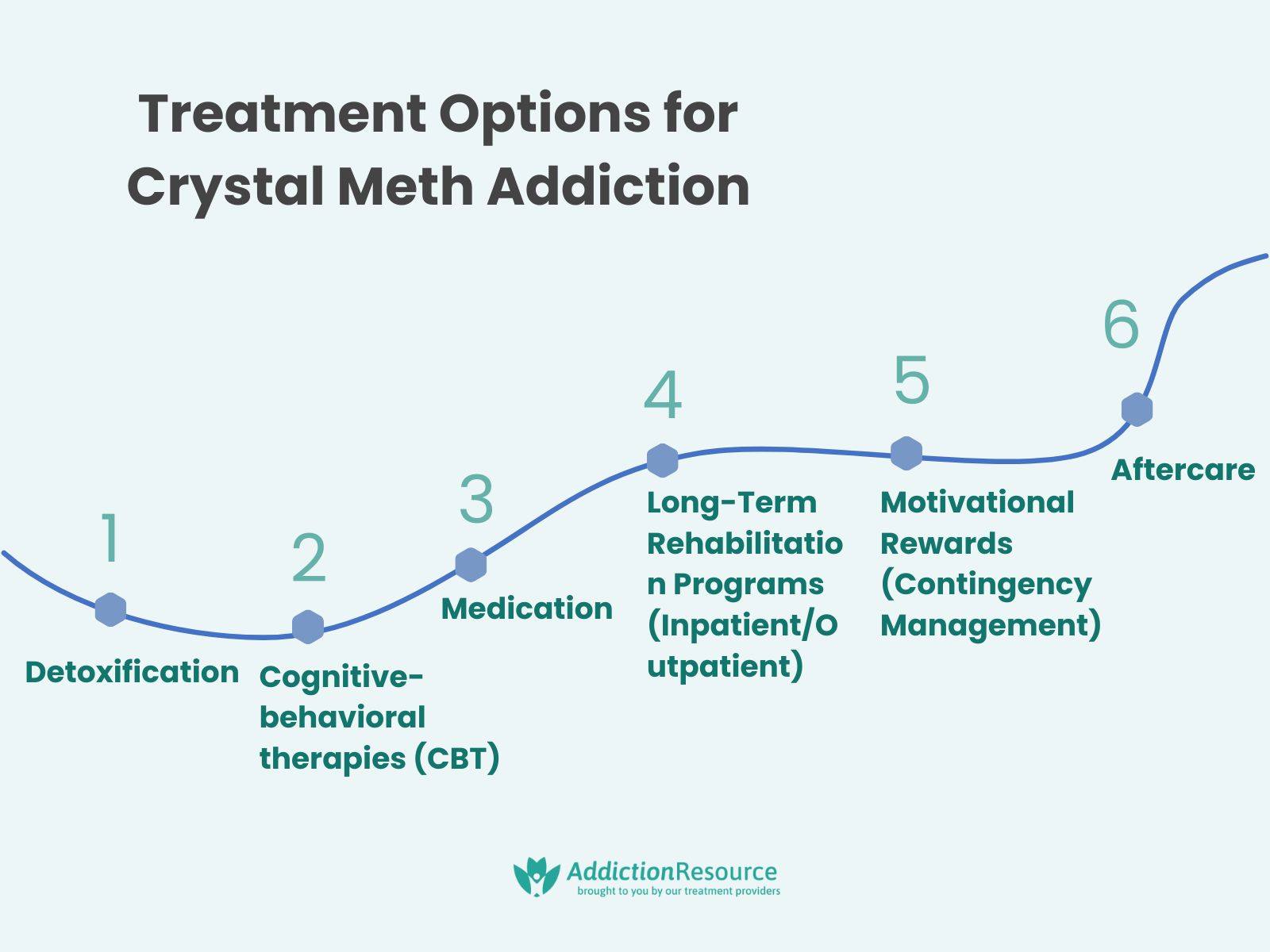
The treatment options for crystal meth addiction include detoxification, cognitive-behavioral therapies, medication, and long-term rehabilitation programs.
The 6 best treatment options for crystal meth addiction are listed below.
- Detoxification: Detoxification is an initial phase that involves clearing methamphetamine from the body under medical supervision to manage withdrawal symptoms. The detox process lasts from several days to a week, depending on the usage history. While detox alone doesn’t address the psychological aspects of addiction, it prepares a meth-addicted person for further treatment.
- Cognitive-behavioral therapies (CBT): CBT helps a meth-addicted person recognize and modify negative thought patterns and behaviors associated with crystal meth use. Therapy duration varies from 12 to 16 weeks.
- Medication: Methamphetamine addiction currently has no FDA-approved medications designed for its treatment. However, certain medications are prescribed to manage withdrawal symptoms or co-occurring mental health disorders.
- Long-Term Rehabilitation Programs (Inpatient/Outpatient): Long-term rehabilitation programs provide structured environments for recovery, with durations ranging from 30 days to several months. Inpatient programs offer intensive support and monitoring, while outpatient programs allow meth-addicted people to maintain daily responsibilities.
- Motivational Rewards (Contingency Management): The motivational reward approach provides vouchers or privileges for maintaining sobriety and participating in treatment. Contingency management reduces methamphetamine use during treatment periods.
- Aftercare: Post-treatment support, including counseling, support groups, and relapse prevention planning, is important for sustaining long-term recovery. Engaging in aftercare reduces the chances of relapse.
What is Crystal Meth Withdrawal?
Crystal meth withdrawal is the physical and psychological symptoms that occur when a person stops the use of crystal methamphetamine after prolonged use. Withdrawal symptoms arise as the body attempts to adjust to the absence of the drug on which it has become dependent. The main crystal meth withdrawal symptoms include intense cravings, extreme fatigue, depression, and in severe cases, suicidal thoughts. Physical symptoms include aches, chills, and insomnia.
What is Crystal Meth?
Crystal meth, a highly addictive synthetic stimulant, impacts the central nervous system and is smoked, snorted, injected, or ingested for intense euphoria and energy. Using Crystal Meth poses severe health risks, including heart attacks and organ damage like liver and kidney failure.
What is the Origin of Meth?
Methamphetamine, first synthesized in 1893 in Japan by Nagai Nagayoshi, was initially developed as a medical stimulant. Its crystalline form, crystal meth, was created in 1919 by Akira Ogata and used extensively during World War II to boost energy and suppress appetite. Over time, it transitioned from a therapeutic drug to a widely abused substance with severe health consequences.
How is Crystal Meth Made?
Crystal meth is made from pseudoephedrine from cold medications combined with toxic chemicals like lithium and ammonia, in a dangerous process carried out in illegal meth labs. This production poses risks of explosions, toxic fumes, and environmental harm.
Is Meth Addictive?
Yes, meth is highly addictive due to its powerful effects on the dopamine system of the brain, which creates intense euphoria and reinforces compulsive use. Methamphetamine floods the brain with dopamine, a neurotransmitter that plays a key role in reward and pleasure. The surge leads to a strong desire to continue using meth, resulting in meth addiction.
Is Crystal Meth Illegal Everywhere?
Yes, crystal meth is illegal in most countries worldwide due to its high risk for abuse, lack of accepted medical use, and severe health risks. Crystal meth is classified as a Schedule II drug in the United States, and its production, possession, or distribution without a prescription is strictly prohibited.
Is Crystal Meth Overdose Dangerous?
Yes, crystal meth overdose is extremely dangerous and causes life-threatening symptoms such as heart attacks, strokes, severe hyperthermia, and organ failure. Crystal meth overdose occurs when the body is overwhelmed by excessive amounts of meth, resulting in a toxic reaction that rapidly deteriorates the health. Symptoms include severe agitation, rapid or irregular heartbeat, chest pain, seizures, and unconsciousness.
How long does Methamphetamine stay in the system?
The effects of meth last between 8 to 24 hours, depending on the dose, time of use, and method of administration (such as intravenous or oral). While the effects of meth last 8 to 24 hours, it has a longer half-life of 10–12 hours, which means that it takes that long for half of the substance to be eliminated from the body.
Hope Without Commitment
Find the best treatment options. Call our free and confidential helpline
Most private insurances accepted



